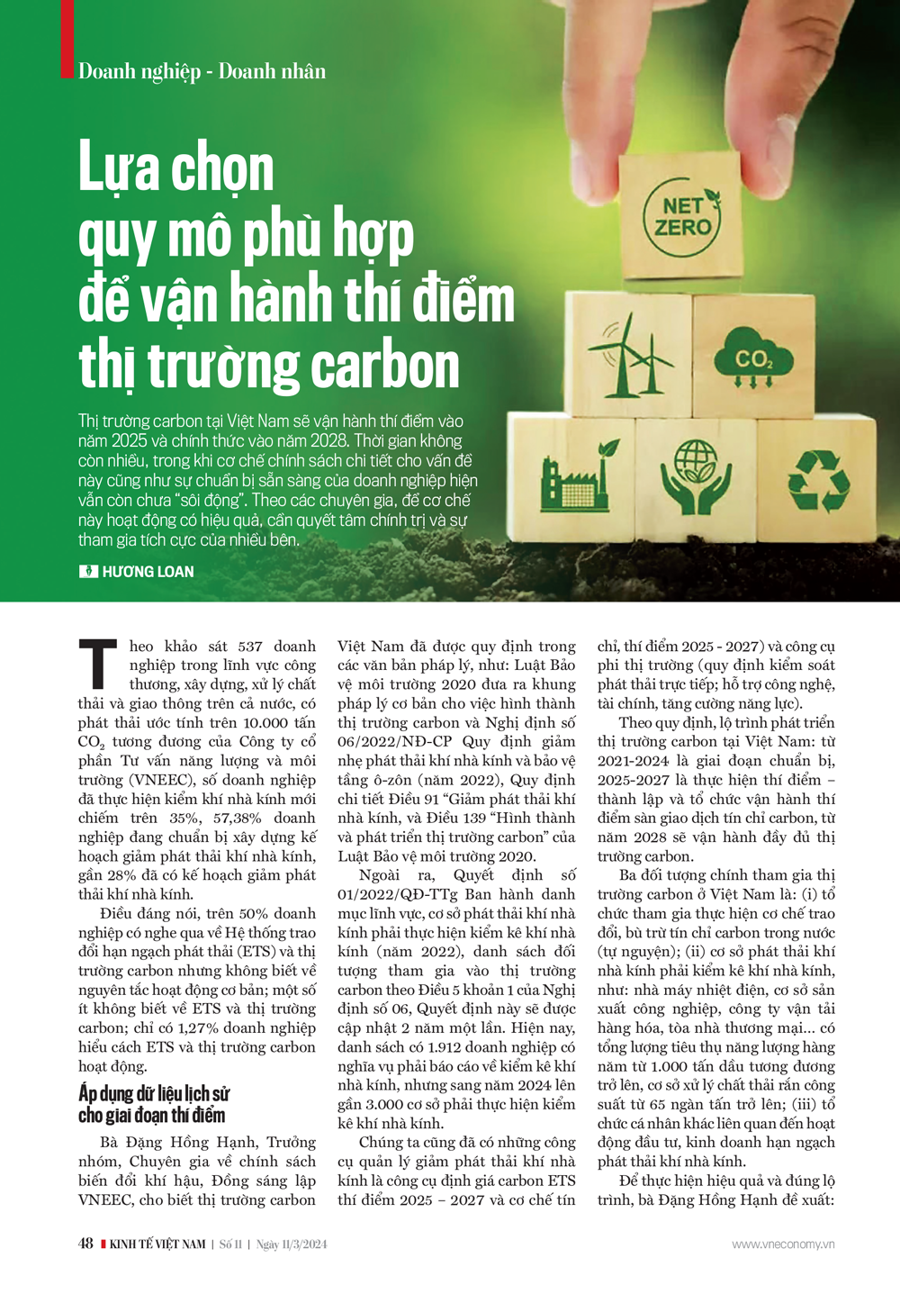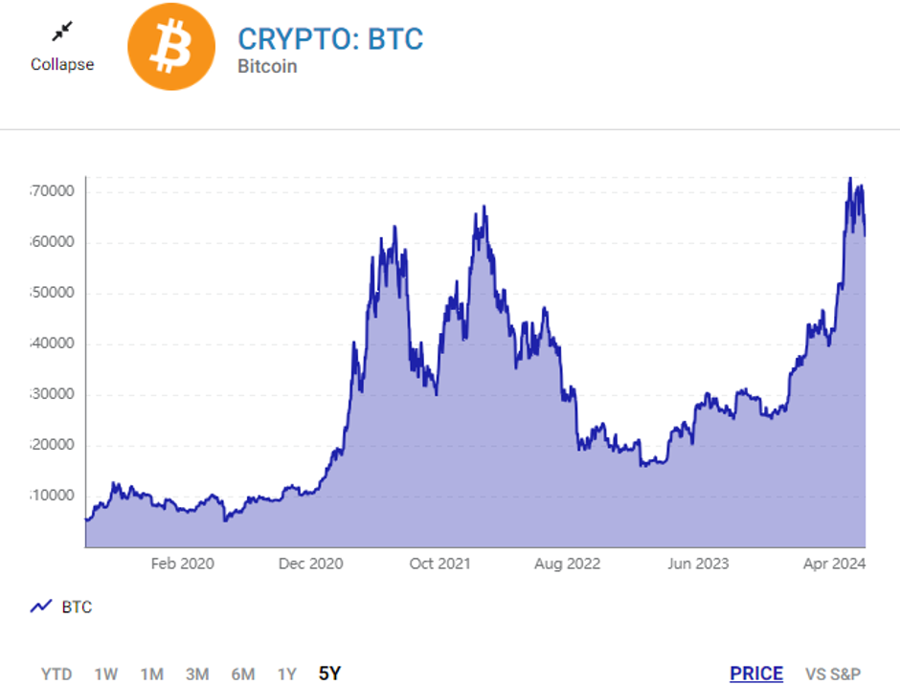According to a survey of 537 businesses in the fields of trade, construction, waste treatment, and transportation nationwide, the estimated emissions of over 10,000 tons of CO2 equivalent were from the Joint Stock Company for Energy and Environment Consultancy (VNEEC). The number of businesses that have implemented the new greenhouse gas testing accounted for over 35%, 57.38% of businesses are preparing to develop greenhouse gas emissions reduction plans, and nearly 28% already have plans for greenhouse gas emissions reduction.
What’s worth noting is that over 50% of businesses have heard about the Emission Trading System (ETS) and carbon markets but are unfamiliar with the basic operation principles; a few are unaware of ETS and carbon markets, and only 1.27% of businesses understand how ETS and carbon markets operate.
APPLYING HISTORICAL DATA FOR THE PILOT PHASE
Ms. Dang Hong Hanh, Group Leader, Climate Policy Expert, Co-founder of VNEEC, stated that the Vietnamese carbon market has been regulated in legal documents such as the 2020 Environmental Protection Law, which provides a basic legal framework for the formation of the carbon market, and Decree No. 06/2022/NĐ-CP on Greenhouse Gas Emission Reduction and Ozone Layer Protection in 2022, which details Article 91 “Greenhouse Gas Emission Reduction” and Article 139 “Formation and Development of Carbon Markets” of the 2020 Environmental Protection Law.
In addition, Decision No. 01/2022/QD-TTg was issued to establish a list of sectors and facilities that emit greenhouse gases and must conduct greenhouse gas testing in 2022, and the list of participants in the carbon market according to Article 5, Clause 1 of Decree No. 06. This decision will be updated every two years. Currently, the list includes 1,912 businesses obligated to report on greenhouse gas testing, but it will increase to nearly 3,000 facilities by 2024.
We also have tools to manage greenhouse gas emissions, such as the Carbon Emission Allowance Trading System (ETS) pilot project from 2025 to 2027, and the credit mechanism pilot project from 2025 to 2027, as well as non-market tools (direct emission control regulations; technology, financial support, capacity enhancement).
According to regulations, the roadmap for the development of the carbon market in Vietnam is: from 2021 to 2024 is the preparation phase, from 2025 to 2027 is the pilot implementation phase – the establishment and operation of the pilot carbon credit trading platform, and from 2028, the full operation of the carbon market.
The three main participants in the carbon market in Vietnam are: (i) organizations participating in the voluntary domestic carbon credit exchange and offset mechanism; (ii) greenhouse gas-emitting facilities that must conduct greenhouse gas testing, such as thermal power plants, industrial production facilities, freight transport companies, commercial buildings, with annual energy consumption of over 1,000 tons of oil equivalent, waste treatment facilities with a capacity of over 65,000 tons; (iii) other organizations and individuals related to investment and business activities that have greenhouse gas emission quotas.
To achieve effectiveness and follow the roadmap, Ms. Hanh proposed that in 2024, we select an option for the pilot phase and design the ETS, while issuing more detailed legal documents for the pilot phase and complete ETS design, including setting emission caps and allocating quotas.
In 2025, the pilot activities will be carried out, preparing designs for the complete ETS, and issuing additional legal documents for the pilot phase and complete ETS design. In 2026-2027, the pilot activities will be implemented, designs for the complete ETS will be prepared, and additional legal documents for the pilot phase and complete ETS design will be issued. In 2028, the full operation of the ETS will begin.
To succeed, according to Ms. Hanh, it is important to have national databases that include data on emissions from all levels – only when we have this data can we accurately allocate quotas. Currently, the Decree 06 specifies the method of allocating quotas based on the average emissions of the industry, but when consulting the steel industry in South Korea or the EU, they took 7 years to obtain industry emission testing data.
Therefore, experts recommend first applying historical data for the pilot phase and properly determining the quota allocation process. According to Ms. Hanh, greenhouse gas emission databases at all three levels (businesses, localities, ministries) play a crucial role because without knowing where our industry stands, there can be no accurate quota allocation for businesses or a basis for allocating quotas to businesses.
ENTERPRISES NEED SPECIFIC IMPLEMENTATION PLANS
Regarding the coordination of activities and market stability, Ms. Hanh believes that it is necessary to identify intervention measures for market stability and specify under which situations intervention will occur. For example, South Korea did not intervene initially, but during the operation of the market, interventions were necessary when prices were too high or too low by adjusting policies.
The VNEEC consultancy team believes that the time from now until the pilot phase (2025) is very short, while other countries have had pilot periods of 3-6 years. Therefore, it requires the determination of the Vietnamese Government, the issuance of more detailed legal documents, and active participation from various parties. We need to simultaneously carry out multiple tasks and select an appropriate pilot scale. In particular, the ETS issue involves many new technical and management requirements, so we need to train human resources and issue many legal documents and guidelines in 2024, which is a very heavy task.
From an enterprise perspective, Mr. Björn Fondén, International Emissions Trading Association (IETA), believes that the benefits for businesses include: participation in the domestic and international carbon markets, which can bring additional revenue; attracting green investment capital and enhancing competitive positions through innovative high-tech product activities; enhancing technological innovation, entering new markets; reducing financial and operational risks, etc.
https://postenp.phaha.vn/chi-tiet-toa-soan/tap-chi-kinh-te-viet-nam








































![[IR AWARDS] March 2024 Information Release Schedule Reminder](https://xe.today/wp-content/uploads/2024/03/ir-awards--100x70.jpg)

